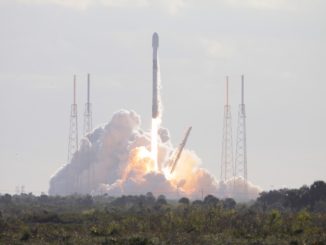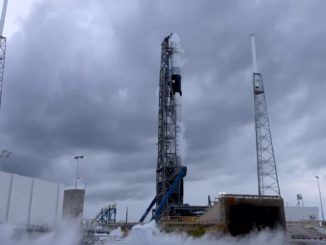
The European Space Agency has reserved an Ariane launcher to send a spacecraft toward Jupiter in May 2022, and the mission’s project manager said Tuesday officials could assign the probe to Europe’s new Ariane 6 rocket, assuming the vehicle has a successful debut by the end of 2020.
The Jupiter Icy Moons Explorer, or JUICE, mission will be the first European-led mission to the outer solar system, and could become the third or fourth mission to orbit the gas giant, depending on the final arrival date of the Europa Clipper spacecraft from NASA.
The JUICE launch contract with Arianespace was not a surprise, but officials inserted a provision that allows ESA to launch the mission on the new Ariane 6 rocket scheduled for an inaugural flight in the second half of 2020.
“The mass (of the JUICE spacecraft) with the fuel is 5.6 tonnes (12,345 pounds), so if we launch with a European launcher, which was planned from the beginning, we can launch only with the Ariane, either the Ariane 5 or Ariane 64,” said Giuseppe Sarri, project manager for the JUICE mission at the European Space Agency.
Fitted with four strap-on solid rocket boosters, the Ariane 64 is the more powerful of the two Ariane 6 rocket variants, generating some 3.5 million pounds of thrust at sea level. Another configuration, named the Ariane 62, will feature two solid rocket boosters clustered around the launcher’s hydrogen-fueled core.
The Ariane 5 rocket, which has flown more than 100 times, will be retired after the successful debut of the Ariane 6 rocket. The first Ariane 6 launch will fly in the Ariane 62 configuration with around 30 commercial broadband satellites for OneWeb, followed by the debut of the Ariane 64.
If the Ariane 6 runs into delays, or suffers a failure on one of its early missions, ESA will launch JUICE on an Ariane 5, officials said.
For now, the Ariane 5 rocket remains the “baseline” for JUICE’s launch, Sarri said. Engineers are still examining the compatibility of the JUICE spacecraft with the Ariane 6, which will have different vibration and acoustic characteristics than the Ariane 5.
“We will launch JUICE only after the Ariane 64 has been proven, and today, if we launch in 2022, if everything goes as planned, we will launch probably on the third or fourth Ariane 64 launch,” Sarri said in an interview Tuesday with Spaceflight Now. “We will not be the first one.”
An Ariane 64 launch would be less expensive than an Ariane 5 launch, Sarri said, and the new rocket could give JUICE slightly more speed as it departs Earth.
After its launch, JUICE will use gravitational assist flybys — three with Earth, one with Venus, and one with Mars — to gain momentum to slingshot the massive spacecraft toward Jupiter.
“On the trajectory to Jupiter, either way, we will have to do gravity assist maneuvers, but if we use less fuel because the launch is a little more powerful, we may need less fuel (on the way to Jupiter),” Sarri said. “Then we can use the fuel to do lower orbit at Ganymede at the end of the mission.”
JUICE is on schedule for liftoff from French Guiana, either on the Ariane 5 or Ariane 64, during a 20-day launch period that opens May 20, 2022, Sarri said.
Assuming a launch in May or June 2022, JUICE will reach Jupiter in October 2029 and conduct a series of close flybys of three of Jupiter’s icy moons — Callisto, Europa and Ganymede — before entering orbit around Ganymede itself in December 2032. With the final phase of JUICE’s mission at Ganymede, the spacecraft will become the first in history to orbit around the moon of another planet.

The mission’s 10 remote sensing, geophysical and in situ instruments, including a camera suite, spectrometers, a laser altimeter for topographic measurements, an ice-penetrating radar, and a package of plasma wave sensors, particle detectors, a magnetometer, and a payload to study the gravity field of Jupiter and its moons.
Scientists want to learn more about Jupiter’s atmosphere and magnetosphere, and collect up-close data about Jupiter’s three moons believed to harbor underground oceans of liquid water.
“JUICE is the first ‘large-class’ mission in our Cosmic Vision program and of prime importance for investigating the habitability potential of ocean-worlds beyond our own,” said Günther Hasinger, ESA’s director of science. “We’re delighted to confirm it will have a flying start with an Ariane launch vehicle, setting it on course to fulfil its scientific goals in the Jupiter system.”
Sarri said JUICE is forecast to cost around 1.5 billion euros, or nearly $1.7 billion at current exchange rates. That figure includes contributions from ESA, which is responsible for the spacecraft, mission management and the launch, and from individual ESA member states funding JUICE’s scientific payload.
“Arianespace is honored to be awarded this new scientific mission from ESA, which will advance our understanding of the universe. Less than a year after the launch of BepiColombo to Mercury, we have won the launch contract for the JUICE mission to Jupiter’s moons, further confirmation of Arianespace’s ability to ensure Europe’s independent access to space for all types of missions,” said Stephane Israel, CEO of Arianespace, in a statement.
“We are once again marshaling all of our strengths and capabilities to support Europe’s spaceborne ventures, with a launch services offering based on Ariane 5 and Ariane 6 so we can deliver the availability and flexibility needed by ESA for its latest emblematic mission,” Israel said.

Managers from ESA and industry completed a major engineering review earlier this year to finalize the design of the JUICE spacecraft.
“The design is frozen, and we are already producing the flight models,” Sarri said. “The structure and the tanks are already produced, the main engine is already produced, the on-board computer is already produced. So we’re making flight hardware, and we will start integration of the spacecraft in August, integrating the chemical propulsion subsystem on the structure.”
Airbus Defense and Space will assemble the spacecraft at its production site in Friedrichshafen, Germany, then deliver JUICE to ESA’s test facility in the Netherlands for testing.
Sarri told Spaceflight Now the most challenging components of the JUICE mission are its scientific instruments and solar arrays, which will cover an area of than 1,044 square feet (97 square meters) once unfurled in space. The huge solar panels are needed to generate electricity at Jupiter — some 500 million miles (nearly 800 million kilometers) from the sun — and will become the largest ever flown on an interplanetary mission.
“Our big worry was the structure and the tanks, but they are coming,” Sarri said. “In a couple of months, they’ll be delivered. The second thing is the solar array. The solar array is a very complex development and will arrive late in the program, It’s probably one of the last elements to be delivered in ’21.”
Email the author.
Follow Stephen Clark on Twitter: @StephenClark1.



